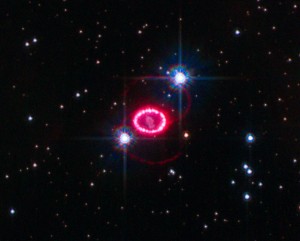
OK, why the name 1987A … well basically because it was first discovered in … yep, you guessed it … 1987.
What you have here is a Supernova in the Large Magellanic Cloud (LMC) that is a jaw dropping 160,000 light-years (49 kiloparsecs) away. Now least you wonder, its not in our Galaxy, the nearby Large Magellanic Cloud is a dwarf galaxy that is adjacent to our own Milky Way Galaxy. So, what you see is what was there 160,000 years ago. Its also the closest exploding star to Earth to be detected since 1604.
Now look closely, it looks really weird, a ring a lights, so what is this? It looks artificial and is tempting to speculate that some hyper-smart alien race has been engineering on a Galactic scale, but thats not what you have here. What you see is a glowing 6-trillion-mile-diameter ring of gas encircling the supernova remnant. The gas ring was probably shed some 20,000 years before the supernova exploded. Shock waves resulting from the impact of the ejecta onto the ring have brightened 30 to 40 pearl-like “hot spots” in the ring. These blobs likely will grow and merge together in the coming years to form a continuous, glowing circle.
“We are seeing the effect a supernova can have in the surrounding galaxy, including how the energy deposited by these stellar explosions changes the dynamics and chemistry of the environment,” said University of Colorado at Boulder Research Associate Kevin France of the Center for Astrophysics and Space Astronomy. “We can use these new data to understand how supernova processes regulate the evolution of galaxies.”
Using this data, an international team of astronomers using the Hubble Space Telescope reported a significant brightening of the emissions from Supernova 1987A. The results, which appear in the 2nd Sept issue of Science magazine, are consistent with theoretical predictions about how supernovae interact with their immediate galactic environment, so no magic, no supernatural entities and no aliens needed to explain this extraordinary image.
Credit for this goes to: NASA, ESA, K. France (University of Colorado, Boulder), and P. Challis and R. Kirshner (Harvard-Smithsonian Center for Astrophysics)
Link for more details:
- Observing Supernova 1987A with the Refurbished Hubble Space Telescope by France et al., 2010 (PDF document)
Abstract for the paper:
Observations with the Hubble Space Telescope (HST), conducted since 1990, now offer an unprecedented glimpse into fast astro-physical shocks in the young remnant of supernova 1987A. Comparing observations taken in 2010 using the refurbished instruments on HST with data taken in 2004, just before the Space Telescope Imaging Spectrograph failed, we find that the Lyα and Hα lines from shock emission continue to brighten, while their maximum velocities continue to decrease. We observe broad blueshifted Lyα, which we attribute to resonant scattering of photons emitted from hotspots on the equatorial ring. We also detect N λλ1239,1243 Å line emission, but only to the red of Lyα. The profiles of the N lines differ markedly from that of Hα, suggesting that the N4+ ions are scattered and accelerated by turbulent electromagnetic fields that isotropize the ions in the collisionless shock.
Key words: hydrodynamics – shock waves – supernovae: individual (SN 1987A) – ISM: supernova remnants